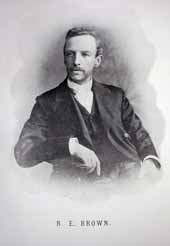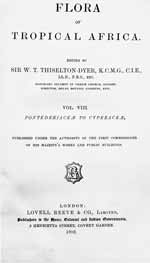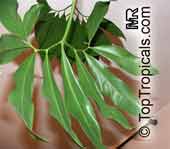Aroideae
|
N. E. Brown (1901), Aroideæ. in: Flora of tropical Africa. Vol. VIII.—Part II. pp. 138-139 ORDER CL. AROIDEÆ. (By N. E. Brown.)
|
|
Zamioculcas |
N. E. Brown (1901), Aroideæ. in: Flora of tropical Africa. Vol. VIII.—Part II. p. 195-197 19. ZAMIOCULCAS, Schott ; Benth. et Hook. fil. Gen. PL. iii. 993. Spathe convolute at the base ; limb horizontally spreading or somewhat reflexed. Spadix free, sessile, monœcious, stout, shorter than the spathe, constricted above the ovaries, without neuter organs or appendix ; female part short, cylindric ; male part cylindric or subclavate, obtuse, closely contiguous to the female, with the lower flowers abortive. Perianth-segments 4, present in both sexes, thickened at the angular truncate apex. Female flowers: Stamens none. Ovary subglobose or ovoid, 2-celled ; style short, cylindric ; stigma exserted just beyond the perianth, discoid, ; ovule solitary in each cell, erect, anatropous, on a short funicle. Male flowers with 4 stamens surrounding an abortive ovary, included ; filaments short, free ; anthers small, 2-celled, slightly connate ; cells divergent at the base, opening by transverse slits.—A perennial evergreen herb, with a stout creeping rhizome. Leaves pinnate ; petiole with a thickened articulation above the middle. Peduncles short, solitary, axillary. Endemic, monotypic. |
Zamioculcas Loddigesii(Synonym of |
1. Z. Loddigesii, Schott, Synop. Aroid. 71. Rhizome stout, creeping. Leaves all radical, erect, pinnate, 1½–2 ft. long, including the petiole, glabrous ; petiole stout, shortly sheathing at the base, with a swollen articulation above the middle ; leaflets opposite or alternate, 3½–5½ in. long, 1–2 in broad, oblanceolate, acute, cuneately narrowed to the base from above the middle, articulated to the petiole and at length deciduous. Peduncle 1½–2½ in. long, 2 lin. thick, glabrous, surrounded by several bracts. Spathe green, glabrous ; tube subglobose, about ½ in. long and broad ; limb 1½–2 in. long, about 1 in. broad, ovate-oblong, acute, horizontally spreading or reflexed. Spadix stout, about 5 lin. thick, constricted above the female part, very obtuse, whitish ; female part ½ in. long ; male part 9–11 lin. long. Fruit not seen.— Schott, Prod. Aroid. 214 ; Decsne in Bull. Soc. Bot. France, xvii. 321 ; Bot. Mag. t. 5985 ; Engl. in Nov. Act. Acad. Leopold. Nat. Cur. xxxix. 201, t. 13, fig. 24, in DC. Monogr. Phan. ii. 208, Jahrb. i. 189, and Pfl. Ost-Afr. C. 131 ; Engl. & Prantl, Pflanzenfam. ii. iii. 117 ; Lynch in Gard. Chron. 1880, xiv. 375 ; Durand & Schinz, Conspect. Fl. Afr. v. 472. Caladium zamiæfolium, Lodd. Bot. Cab. t. 1408. Nile Land. British East Africa : Rabai Hills, near Mombasa, Taylor ! Mozamb. Dist. Zanzibar, cultivated specimens, Kirk ! Boivin (ex Decaisne), Hildebrandt (ex Engler). Also found on the Island of Bourbon according to Engler. This plant is remarkable among Aroids in having truly pinnate leaves, with the leaflets articulated to the petiole, which character, however, is also shared by the very remarkable American genus Thaumatophyllum. The Leaflets, after falling to the ground, have the property of forming a small tuber at their base, which ultimately develops into a young plant. This peculiarity was first discovered at Kew by Mr. R. J. Lynch in 1874 or earlier, according to a note in the Kew Herbarium, and as stated by him in the Gard. Chron., l.c. Subsequently the same thing was rediscovered by Herr Hild, of Kiel University Botanic Garden, as detailed by Prof. Engler (ll.cc.). |
|
Gonatopus |
20. GONATOPUS, Hook f. in Bot. Mag. sub t. 6026. Spathe convolute at the base ; limb horizontally reflexed, or revolute. Spadix free, sessile, monœcious, stout, shorter than the spathe, constricted above the ovaries, without neuter organs or appendix ; female part short, cylindric, closely contiguous to the long cylindric male part, in which the lowest flowers are more or less imperfect. Perianth-segments 4, present in both sexes, free, somewhat thickened at the angular truncate apex. Female flowers : Staminodes none. Ovary ovoid, 2-celled ; style short, stout ; stigma exserted just beyond the perianth, peltate, rather large ; ovule solitary in each cell, erect, anatropous, with a very short funicle. Male flowers with 4 stamens, connate into a tube around an abortive ovary, included ; anthers short and broad, 2-celled ; cells opening by terminal introrse pores.—Tuberous-rooted herbs with the habit of an Amorphophallus. Leaf solitary, annual, tripinnate in the adult stage, pinnate or bipinnate in young plants ; petiole with a thickened articulation at about the middle. Peduncles 1–2 to a tuber, shorter than the petiole, contemporary with the leaf. An endemic genus of 2 species. Very similar to Zamioculcas in floral structure, the only technical difference being that the filaments of the stamens are connate into a tube in Gonatopus and free in Zamioculcas, the habit, however, is entirely different.
|
Gonatopus Boivinii |
1. G. Boivinii, Hook. f. in Bot. Mag. sub t. 6026. Tuber depressed 3–5 in. in diam. Leaf solitary, erect, 2–3 ft. high, 3–4-pinnate in the adult state, glabrous ; lowest branches 12–15 in. long, 7–8 in. broad ; leaflets 1½–3 in. long, 7–15 lin. broad, varying from lanceolate to elliptic-lanceolate, acuminate, rounded or cuneate at the base, shortly petiolulate or subsessile, not decurrent ; petiole stout, with a swollen articulation at the middle, green, transversely banded with blackish-green ; in juvenile plants the leaf is simply pinnate, with a few large elliptic or suborbicular shortly cuspidate petiolulate leaflets. Peduncles 1–2 to a tuber, produced with the leaf, 15–16 in. long, erect, moderately stout, glabrous, coloured like the petiole and, with the latter, enclosed at the base by 2 or 3 membranous acute sheaths. Spathe glabrous, dull green, striate with dark green outside, pale greenish-yellow inside ; tube about 1 in. long, ovoid or subglobose ; limb 5–8 in. long, 1½ in. broad, oblong, acuminate into a long subulate point, expanded, recurved or revolute. Spadix sessile ; female part about ¾ in. long and about ½ in. thick ; male 2¼–3½ in. long, about 5 lin. thick, constricted at the base, with the lowest flowers more or less imperfect. Perianth-segments of both male and female flowers oblong, truncate at the triangular apex. Ovary ovoid, narrowed into a short style, 2-celled ; stigma large, peltate, just exserted from the perianth, pea-green. Stamens in the male flowers 4, connate, around an abortive ovary, entirely absent in the female flowers ; anthers subquadrate, white. Fruit not seen.—Engl. in DC. Monogr. Phan. ii. 209 ; Pflanzenfam. ii. iii. 117, and Pflanzenw. Ost-Afr. C. 131 ; Durand & Schinz, Conspect. Fl. Afr. v. 472. Zamioculcas Boivini, Decsne. in Bull. Soc. Bot. France, xvii. 321 ; Hook. f. in Bot. Mag. t. 6026. Nile Land. British East Africa : Rabai Hills, near Mombasa, Taylor ! Also (according to Engler) in the Island of Réunion. |
Gonatopus angustus |
2. G. angustus, N. E. Br. Tuber turnip-shaped. Leaf solitary, erect, 1½–4½ ft. high, tripinnatipartite, glabrous ; lowest branches 10–12 in. long, about 5 in. broad ; leaflets or ultimate segments 1¼–3 in. long, 1½–4 lin. broad, probably sometimes larger, linear or linear-lanceolate, acute, more or less decurrent at the base, not articulated to the rhachis. Peduncle 2–3 in. long, smooth. Spathe glabrous ; tube 1–1¼ in. long, oblong-ovoid ; limb about 3 in. long, and 1¼ in. broad, reflexed, oblong, cuspidate. Spadix sessile, shorter than the spathe ; female part 8–9 lin. long, about 1/3; in. diam. cylindric ; male part about 2½ in. long, cylindric, obtuse, its basal portion for about 8 lin. constricted to about half the thickness of the upper portion and covered with abortive flowers. Perianth-segments oblong, truncate at the angular apex. Ovary ovoid, narrowed into a short stout style, 2-celled ; stigma rather large, peltate, exserted just beyond the perianth-segments. Stamens in the male flowers 4, connate into a tube around an abortive ovary and equalling it in length, entirely absent in the female flowers. Mozamb. Dist. British Central Africa : Zambesi Valley ; in copses on mountains near Boruma, Menyharth, 922bis ! |
|
this html version © 2008 Norbert Anderwald - All rights reserved |
||
July 6, 2008 |
last update: July 7, 2010 |


